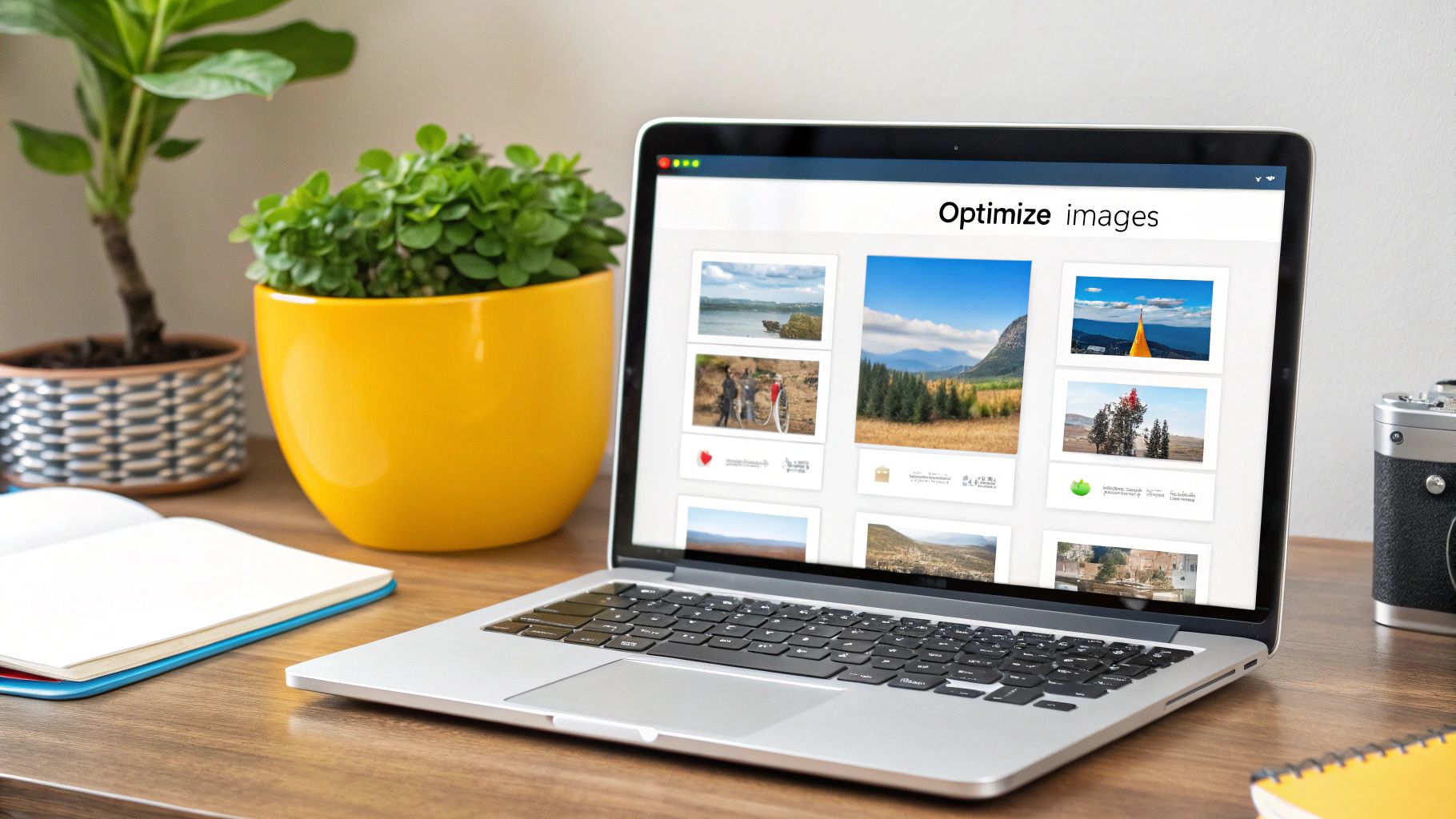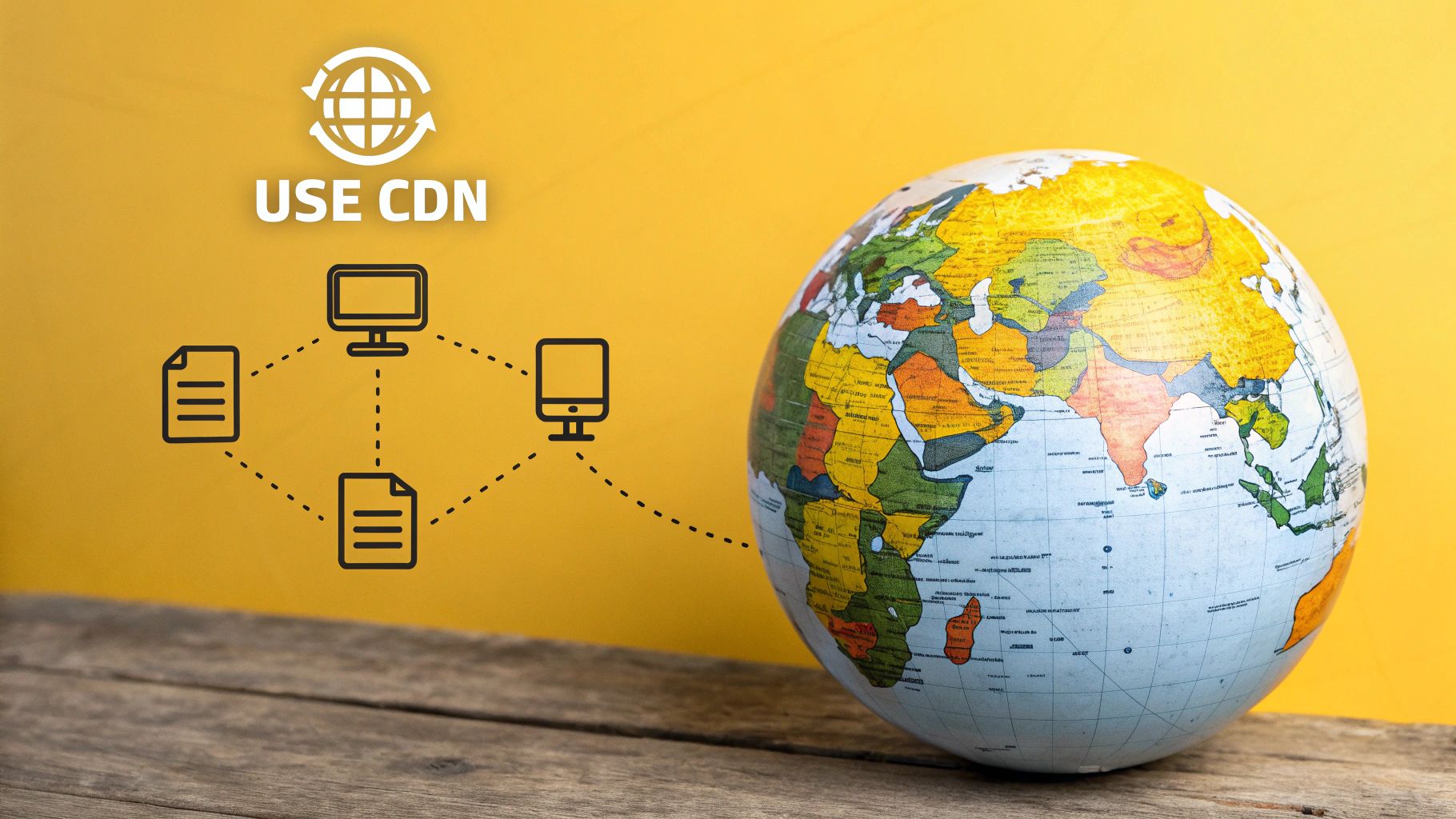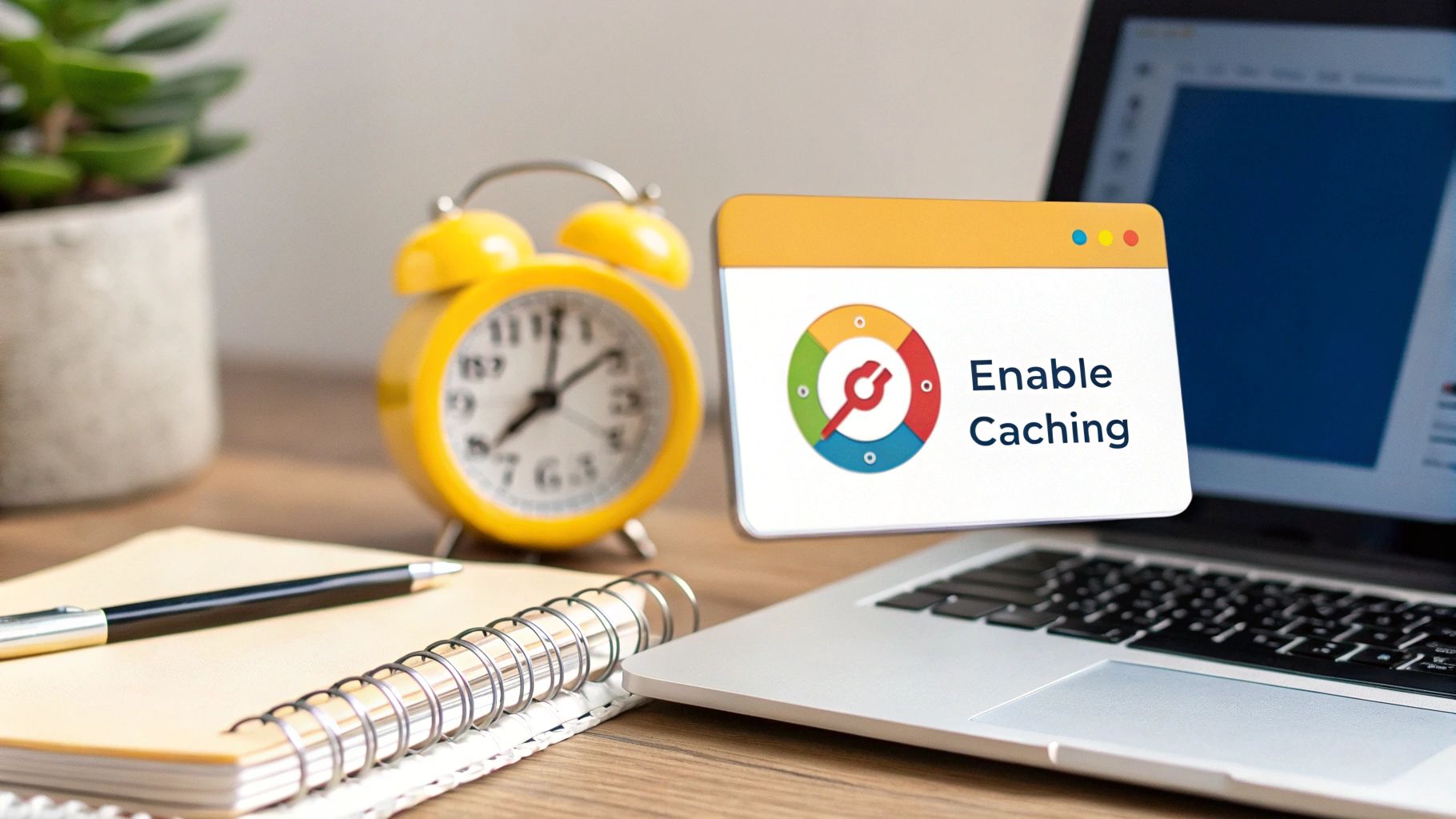How to Improve Website Speed: Top Tips for Faster Sites

If you want to speed up your website, you'll need to tackle it from a few different angles. Things like optimizing your images, setting up browser caching, and minifying your code are the big three to start with. Getting these right lays the groundwork for a much snappier user experience, which ultimately helps your business grow.
Why Website Speed Is a Critical Business Metric
 Before we get into the "how-to," let's talk about the "why." A slow website is more than just a minor hiccup for your visitors; it's a genuine roadblock to your success. Every single second a user has to wait for your page to load, you lose a little bit of their patience, their trust, and their willingness to buy from you.
Before we get into the "how-to," let's talk about the "why." A slow website is more than just a minor hiccup for your visitors; it's a genuine roadblock to your success. Every single second a user has to wait for your page to load, you lose a little bit of their patience, their trust, and their willingness to buy from you.
This isn't just a hunch. We have hard data that proves the link between page speed and business outcomes.
Take a look at how dramatically load times affect conversion rates. The difference between a one-second load and a five-second load is massive.
Impact of Load Time on Conversion Rates
| Load Time | B2C Conversion Rate Lift | B2B Conversion Rate Lift |
|---|---|---|
| 5 Seconds | Baseline | Baseline |
| 4 Seconds | +0.6% | +1.9% |
| 3 Seconds | +1.1% | +3.3% |
| 2 Seconds | +1.7% | +4.4% |
| 1 Second | +2.5x Higher | +3.0x Higher |
The numbers are pretty clear. For a B2B site, loading in just one second can result in a conversion rate three times higher than a site that takes five seconds. For e-commerce, that same one-second load time can boost conversions 2.5 times higher than a slower competitor. It's a stark reminder that speed isn't just a technical detail—it's a core business driver.
The Real Cost of a Slow Site
The financial hit from poor performance can be staggering. Picture an e-commerce store pulling in thousands of visitors every day. A delay of just a single second could translate to thousands in lost revenue daily as frustrated shoppers abandon their carts.
The same goes for a B2B company. A sluggish landing page means fewer people filling out your contact form and fewer qualified leads for your sales team. Your website's first impression is often the only one you'll get, and speed is a huge part of whether that impression is a good one.
A fast website signals professionalism and respect for the user's time. A slow one suggests the opposite, eroding brand credibility before a visitor even sees your product or service.
Speed as a User Experience Pillar
At the end of the day, performance is a fundamental pillar of a great user experience (UX). It sits right alongside design, content, and usability. You can have the most beautiful, well-written website in the world, but if it's too slow to load, none of that matters.
This idea is also central to digital inclusivity. Making sure your site loads quickly for everyone, regardless of their device or network connection, is a big step toward better accessibility. For more on this, you can check out our guide on how to make your website accessible.
When you start thinking of speed as a feature, not just a technical chore, the whole optimization process changes. It becomes a strategic move that elevates your brand, improves your search rankings, and drives real business results. For a deep dive into practical strategies, these essential tips for improving website loading speed are a great resource.
Diagnosing Your Site's Performance Bottlenecks

Before you can fix a slow website, you have to play detective. You need to figure out exactly what's causing the slowdown. It’s not enough to have a vague feeling that your site is sluggish; the first real step is to measure what’s actually happening.
Sure, a simple performance score is a good starting point, but the gold is in the specific metrics that shape what a user actually experiences. These numbers tell a detailed story about how your page loads, becomes interactive, and responds to your visitors.
Your goal isn't just to chase a green score on a testing tool. It's to understand the "why" behind the numbers—to pinpoint the exact bloated script, oversized image, or slow server response that’s holding you back.
This is the phase where you gather the evidence. Without it, any changes you make are just shots in the dark.
Interpreting the Core Metrics
When you run a speed test, you'll be hit with a bunch of different metrics. Don't get overwhelmed. The ones that matter most for user experience are Google's Core Web Vitals. Let's break them down.
- Time to First Byte (TTFB): Think of this as the server's reaction time. It’s how long it takes for your browser to get the very first byte of data back after it makes a request. A high TTFB usually points to a problem on the server side—maybe slow database queries or just a cheap hosting plan that can't keep up.
- Largest Contentful Paint (LCP): This marks the moment when the most important piece of content, like a hero image or a big block of text, finally appears on the screen. A slow LCP is a killer for user experience because people are left staring at a half-finished page, wondering if it's broken.
- Interaction to Next Paint (INP): This one is all about responsiveness. It measures the lag between a user’s action (like clicking a button) and the visual feedback they get on the screen. A high INP is what makes a site feel clunky and unresponsive.
To give you some perspective, the average mobile page hits its largest contentful paint around 1.9 seconds, with a TTFB of roughly 0.8 seconds. These numbers show just how critical it is to get both your server and your front-end assets in order. You can dig into more of these benchmarks and find further details on website speed statistics.
Using Diagnostic Tools Effectively
Your best friends here are tools like Google PageSpeed Insights and GTmetrix. When you run a test, resist the urge to just look at the grade at the top. The real value is buried in the detailed reports.
The "waterfall chart" is where you'll find the most actionable insights. Available in GTmetrix and your browser's own developer tools, it gives you a visual, cascading breakdown of every single request your site makes. You can see precisely how long each script, font, and image takes to load.
This chart is basically a treasure map to your site's performance problems. You might spot a single JavaScript file that’s taking two full seconds to download or a whole series of unoptimized PNG images causing a bottleneck. By analyzing the waterfall, you can build a priority list of the worst offenders and ensure your efforts have the biggest impact from day one.
Mastering Image and Media Optimization

If I had to point to the number one performance killer on most websites I've worked on, it's almost always large, unoptimized media files. It’s no secret that huge images and videos are typically the heaviest assets on a webpage. Getting them under control is one of the most effective ways to see an immediate, tangible improvement in your site's speed.
The great thing is, you don't have to compromise on visual quality to get a faster site. It's all about being strategic with how you prepare and deliver your media, focusing on efficiency from the very beginning.
Switch to Modern Image Formats
For a long time, JPEG and PNG were our go-to formats. But the web has moved on, and modern formats like WebP and AVIF have completely changed the game. They manage to deliver significantly smaller file sizes with the same—or sometimes even better—visual quality.
- WebP: This format, developed by Google, consistently produces images that are 25-35% smaller than JPEGs with no visible drop in quality. It's now supported by all modern browsers, making it a fantastic and safe choice for optimization.
- AVIF: This is the newer, more powerful kid on the block. AVIF can push compression even further than WebP, often creating files that are an astonishing 50% smaller than their JPEG counterparts. Browser support is strong and continues to grow.
Thankfully, many modern CMS platforms and image optimization plugins can handle this for you. They’ll automatically convert your uploaded images to these next-gen formats and serve the best option depending on what your visitor's browser can handle.
Get Smart with Compression and Resizing
Before you even worry about file formats, you need to nail two fundamentals: image dimensions and compression.
First things first: never upload an image that's bigger than it needs to be displayed. If your blog's main content column is 800 pixels wide, there is absolutely no reason to upload a 4000-pixel-wide photo. That just forces the browser to do extra work. Resize your images before you upload them.
Next, apply smart compression. This isn't just about cranking a quality slider down to zero; it's a process that intelligently removes hidden, unnecessary data from the file to shrink its size. For a really thorough breakdown of how this works, check out a professional's guide to smarter file compression.
Defer Off-Screen Media Using Lazy Loading
Think about it: why should a visitor have to download every single image and video on a long page if they only ever see the content at the very top? That’s the exact problem lazy loading solves.
Lazy loading is a simple but powerful technique. It tells the browser to hold off on loading images and videos until a user actually scrolls down and they're about to enter the viewport. This move dramatically cuts down the initial page load time because the browser only has to fetch what's immediately visible. It’s a high-impact change that makes your site feel much faster, especially on long, media-heavy pages like galleries or blog posts.
Caching and CDNs: Your Website's Speed Superchargers

Okay, so you've got your images in order. What's next for making your site fly? The big wins now come from two related technologies: caching and Content Delivery Networks (CDNs).
Don't let the technical names intimidate you. At their core, these are just clever ways to deliver your website's files to visitors much, much faster. Getting a handle on these is a game-changer for improving site speed and keeping your users happy.
The Simple Power of Caching
Think of caching as creating a temporary memory for your website. The first time someone lands on your page, their browser has to download everything from scratch—every image, every script, every style file. Caching tells the browser to save a copy of those files right there on the user's computer.
So, what happens when they click to another page or come back tomorrow? Instead of fetching everything all over again from your server, the browser just grabs the files it already saved. It's instant. This simple trick dramatically speeds up the experience for repeat visitors and takes a significant load off your server.
You'll generally deal with two kinds of caching:
- Browser Caching: This is the local storage on a user's device I just mentioned. It’s controlled by instructions your server sends out and is a must-have for anyone who visits your site more than once.
- Server-Side Caching: This one’s a bit different. Instead of making your server build a page from scratch every time (by pulling data from a database), it saves a pre-built, static HTML version. This makes the initial page load incredibly fast for all visitors, not just returning ones.
If you're on WordPress, this is surprisingly easy to set up. Plugins like WP Rocket or W3 Total Cache handle both types of caching for you, often with just a few clicks. It’s one of the highest-impact things you can do for your site's performance.
Going Global with a Content Delivery Network (CDN)
While caching is a huge help, a Content Delivery Network (CDN) takes speed to the next level, especially if your audience is spread out geographically.
Let's say your web server is located in New York. For someone visiting your site from London, every piece of data has to travel thousands of miles across the Atlantic. That physical distance creates a delay we call latency.
A CDN solves this problem beautifully. It takes copies of your site's "static" assets—the files that don't change often, like images, CSS, and JavaScript—and distributes them to a network of servers all over the globe.
When that user in London visits your site, the CDN is smart enough to deliver the files from a server in London or somewhere else in Europe, not all the way from New York.
Suddenly, that cross-ocean delay is gone. The result is a massive reduction in load time for international visitors. Setting up a CDN used to be a complex task, but today it's often built right into hosting plans. Plus, services like Cloudflare offer powerful free plans that you can get up and running in minutes. It’s one of the most effective ways to give your website a real speed boost worldwide.
Tuning Your Front-End and Back-End Code
Okay, so your images are lean and your caching is working its magic. Now it's time to roll up our sleeves and get into the code itself. This is where we fine-tune the engine room of your website—both the front-end (what your visitors see in their browser) and the back-end (your server and database). Honestly, these technical tweaks are what separate a fast site from a blazing-fast one.
Cleaning Up Your Code Files
Let's start with what the user's browser has to download. Every website is built from files like CSS, JavaScript, and HTML. When developers write this code, it's full of helpful things like comments, spaces, and indents that make it readable for humans. But for a browser? It's just dead weight.
This is where minification comes in. It's a simple, automated process that strips out all that unnecessary stuff, shrinking your file sizes. It might sound minor, but shaving off even a few kilobytes from several files adds up, leading to quicker downloads and a snappier feel.
Taming Unruly JavaScript
JavaScript is a powerful tool, but it's often the biggest bottleneck on modern websites. By default, when a browser encounters a script tag, it stops everything else—it pauses rendering the page to download and run the script. This can leave your visitors staring at a blank screen, even if the rest of the content is ready.
You have to be strategic about how your scripts load.
- Deferring Scripts: Think of this as telling the browser, "Go ahead and download this script, but don't run it until you're done building the main page." The script is fetched in the background without blocking the important visual content.
- Delaying Scripts: This is even more aggressive. It prevents a script from loading at all until a user actually interacts with the page, like by scrolling or clicking. This is a game-changer for heavy third-party scripts like live chat widgets, social sharing buttons, or ad networks that aren't essential for the initial page view.
Getting your script loading order right is how you deliver that "instant" feel that users love. The core content loads first, and the extras follow when needed.
Back-End Performance and Hosting
No matter how optimized your front-end is, it can only be as fast as its foundation. This brings us to the back-end—your server, database, and hosting environment.
Your hosting choice has a massive impact. Cheap shared hosting might seem like a good deal, but you're at the mercy of every other site on that server. A sudden traffic spike on a neighbor's site can bring yours to a crawl. Upgrading to a quality managed host or a VPS often provides the single biggest performance jump you can make.
I’ve seen sites, especially on platforms like WordPress, get an instant 10-20% performance boost from one simple change: updating their PHP version. Newer versions of PHP are just flat-out faster and more efficient. It’s one of the easiest wins out there.
Finally, don't forget your database. Over time, it gets clogged with junk—old post revisions, spam comments, and expired temporary data (transients). Regularly cleaning this out keeps your database lean and your site's queries fast. Think of it as spring cleaning for your server. This kind of back-end maintenance is also a key part of a strong security routine, which you can explore further in our guide to performing a comprehensive website security audit.
To help you keep these concepts straight, here's a quick breakdown of where common optimization techniques fit in.
Front-End vs. Back-End Optimization Techniques
| Technique | Area of Focus | Primary Goal |
|---|---|---|
| Image Compression | Front-End | Reduce file size for faster media downloads. |
| Minification (CSS/JS) | Front-End | Shrink code files by removing unnecessary characters. |
| Defer/Delay JavaScript | Front-End | Prevent scripts from blocking initial page rendering. |
| Browser Caching | Front-End | Store assets on the user's device for faster repeat visits. |
| Upgrading PHP Version | Back-End | Improve server-side code execution speed. |
| Database Cleanup | Back-End | Speed up queries by removing old and unnecessary data. |
| Using a CDN | Both | Distribute assets globally for faster delivery (front-end) via a server network (back-end). |
| Server-Level Caching | Back-End | Store pre-built versions of pages on the server to reduce processing time. |
Understanding whether a bottleneck is on the client-side or server-side is the first step to applying the right fix and making meaningful improvements to your site's speed.
Frequently Asked Website Speed Questions
Even with the best roadmap, you're bound to run into a few questions when you start digging into website optimization. Let's tackle some of the most common ones I hear from clients to clear up any confusion and keep you moving forward.
How Much Does Website Speed Really Affect SEO?
The short answer? A lot. Google has officially confirmed that site speed is a direct ranking factor, especially with the introduction of its Core Web Vitals. But the impact goes much deeper than that.
Think about it from a user's perspective. A slow website is frustrating. This leads to higher bounce rates and people spending less time on your pages—all signals that tell Google your site isn't providing a great experience. So, you get hit twice: once from the direct technical signal and again from the negative user behavior. Improving your site speed isn't just a minor tweak; it’s foundational to a solid SEO strategy.
Think of it this way: Google wants to send its users to websites they’ll love. A slow, frustrating site is the opposite of that. Prioritizing speed shows both users and search engines that you value their time.
A fast, responsive experience is also directly tied to user satisfaction, which is a powerful driver for conversions. You can learn more about how user experience influences results by exploring our guide on how to increase website conversions.
What Is a Good Page Load Time to Aim For?
The magic number everyone talks about is under 2 seconds. Once you cross the 3-second mark, you're in the danger zone and almost certainly losing visitors.
For e-commerce sites, the stakes are even higher. I always tell my clients to aim for under 1.5 seconds if they can. The key is to test your site on a simulated 4G connection, not just your speedy office Wi-Fi. This gives you a real-world benchmark for what most of your mobile visitors actually experience, and that's where speed truly counts.
Can I Improve Website Speed Without Being a Developer?
Absolutely. You don't have to be a coding wizard to make a huge difference. While some of the more advanced optimizations do require technical know-how, many of the most impactful changes are surprisingly accessible.
If you're on a platform like WordPress, for example, you can get most of the way there with the right tools:
- Image Optimization: Plugins can automatically compress images, convert them to modern formats like WebP, and set up lazy loading for you.
- Caching: A good caching plugin can handle complex browser and server-side caching with just a few clicks in its settings.
- Hosting: Sometimes, the easiest win is just upgrading your hosting. A quality managed provider handles many server-level optimizations for you behind the scenes.
Focusing on these three areas—images, caching, and hosting—will often get you 80% of the way there without ever looking at a line of code. These principles apply across most platforms, too. For a detailed breakdown of performance issues on other systems, checking out some strategies to fix slow Shopify website speed can provide some excellent insights.